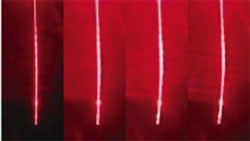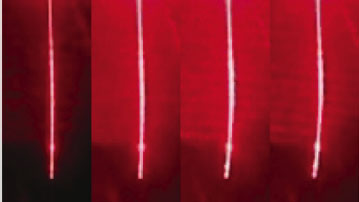Light Bends Glass
Light gives a push rather than a pull when it exits an optical fiber, according to experiments reported in the 12 December Physical Review Letters. The observations address a 100-year-old controversy over the momentum of light in a transparent material: Is it greater or smaller than in air? In the experiments, a thin glass fiber bends as light shines out the end, apparently a recoil in response to the light gaining momentum as it passes from glass to air. But the many experimental subtleties mean that the issue is unlikely to be settled soon.
Light moves slower inside a material than it does in air or vacuum. In 1908 German mathematician Hermann Minkowski suggested that the momentum of light goes up as its speed goes down. A year later, German physicist Max Abraham claimed the exact opposite, that the momentum goes down with decreasing speed.
Abraham might appear to be correct, since the momentum of ordinary objects always goes down with decreasing speed. But Minkowski seems to be favored by quantum mechanics, which says that a photon’s momentum goes up as the light’s wavelength decreases–and the wavelength always shortens as light enters a material from air. Many theoretical arguments appear to point to an Abraham momentum, but most of the experimental evidence to date argues for Minkowski. The experimental difficulty is that in most cases, both formulations lead to the same predicted forces, after one accounts for the momenta of both the light and the medium. So experiments must be carefully designed to isolate the effect of the light’s momentum and avoid other phenomena, such as thermal effects, that can mask the light-induced force.
In their experiment, Weilong She of Zhongshan University in Guangzhou, China, and his colleagues used a filament of silica half a micron wide and 1.5 millimeters long. As the fiber dangled vertically, the researchers shined 270-millisecond laser pulses at a wavelength of 650 nanometers down the fiber. As the light pulses exited out the bottom, a gain in momentum (à la Abraham) would cause the fiber to recoil back like a gun, whereas a loss (à la Minkowski) would pull the fiber straight down. “When I began this experiment, I was really unsure which one is correct,” She recalls. The fiber bowed outward with each pulse, which the researchers say is a sign that it’s recoiling as Abraham would predict.
The researchers performed a second experiment with a longer fiber and continuous–rather than pulsed–laser light and found similar results. The tip of the hanging fiber moved sideways like a pendulum by about 30 microns, which agreed with the tiny force (less than a billionth of a Newton) that they predicted. The team also verified that thermal effects, such as heat expansion, would be too small to influence the fiber’s movement.
However, there may be other forces not accounted for. “A lot of things could make the fiber bend,” says Miles Padgett of the University of Glasgow in England. He thinks this is a “really creative contribution” to the Abraham-Minkowski debate but doesn’t end it. “It would be fairer to say that in their particular experiment Abraham is compatible with the observed result.” Padgett says Minkowski still appears compatible with other observed phenomena, such as the recoil of cold atoms from photon absorption [1] and the stretching of biological cells between a pair of opposing lasers [2].
But Rodney Loudon from the University of Essex in England thinks previous experiments have studied complicated objects with only indirect relations to the basic theory. “By contrast, She et al. seek to measure an easily-calculated quantity with a direct interpretation in terms of the Abraham momentum,” he says.
–Michael Schirber
Michael Schirber is a Corresponding Editor for Physics Magazine based in Lyon, France.
References
- G. K. Campbell et al., “Photon Recoil Momentum in Dispersive Media,” Phys. Rev. Lett. 94, 170403 (2005)
- J. Guck et al., “The Optical Stretcher: A Novel Laser Tool to Micromanipulate Cells,” Biophys. J. 81, 767 (2001)
More Information
Momentum From Nothing (Focus story from 2004)





